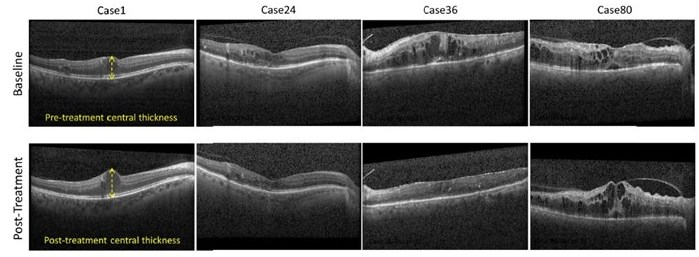Jan 29 2020
A new technique that involves using artificial intelligence to investigate retinal images could someday assist doctors to choose the best treatment for patients suffering from vision loss caused by diabetic macular edema. This complication due to diabetes is the main reason for vision loss among working-age adults.
 Researchers developed a new algorithm that can use a single OCT scan to predict whether a patient with diabetic macular edema is likely to respond to anti-VEGF treatments. They tested it on pretreatment OCT images (top row) and used post-treatment OCT images (bottom row) to track response to treatment. Case 24 and 36 responded to treatment. Image Credit: Sina Farsiu, Duke University.
Researchers developed a new algorithm that can use a single OCT scan to predict whether a patient with diabetic macular edema is likely to respond to anti-VEGF treatments. They tested it on pretreatment OCT images (top row) and used post-treatment OCT images (bottom row) to track response to treatment. Case 24 and 36 responded to treatment. Image Credit: Sina Farsiu, Duke University.
The first line of therapy for diabetic macular edema involves extensive usage of anti-vascular endothelial growth factor (VEGF) agents. However, these agents do not work for everyone. Finding out who would benefit from the therapy is essential since it necessitates multiple injections that are not just expensive but also burdensome for both physicians and patients.
We developed an algorithm that can be used to automatically analyze optical coherence tomography (OCT) images of the retina to predict whether a patient is likely to respond to anti-VEGF treatments. This research represents a step toward precision medicine, in which such predictions help clinicians better select first-line therapies for patients based on specific disease conditions.
Sina Farsiu, Research Team Leader, Duke University
In Biomedical Optics Express journal, from The Optical Society (OSA), Farsiu and team demonstrate the ability of the new algorithm to correctly predict whether a patient will possibly respond to anti-VEGF therapy, by investigating just one pre-treatment volumetric scan.
Our approach could potentially be used in eye clinics to prevent unnecessary and costly trial-and-error treatments and thus alleviate a substantial treatment burden for patients. The algorithm could also be adapted to predict therapy response for many other eye diseases, including neovascular age-related macular degeneration.
Sina Farsiu, Research Team Leader, Duke University
Predicting Treatment Response
The team’s algorithm is based on an innovative convolutional neural network (CNN) architecture, a kind of artificial intelligence with the ability to investigate images by giving importance to a number of objects or aspects.
The algorithm was used by the researchers to analyze images obtained with OCT, a noninvasive technology that generates high-resolution cross-sectional retinal images and is the standard of care for evaluating and treating various conditions of the eye.
Unlike previously developed approaches, our algorithm requires OCT images from only a single pretreatment timepoint. There’s no need for time-series OCT images, patient records or other metadata to predict therapy response.
Reza Rasti, Study First Author, Duke University
Rasti is a postdoctoral scholar in Farsiu’s lab.
Apart from preserving and highlighting global structures in the OCT image, the new algorithm also enhances local features from affected regions to make efficient use of the information related to retinal thickness. The team added an additional step to assist with treatment decision-making. This step involves searching for CNN-encoded features highly correlated with the anti-VEGF response.
Testing the Algorithm
The new algorithm was tested by the researchers with OCT images obtained from 127 patients treated for diabetic macular edema by administering three consecutive injections of anti-VEGF agents.
The algorithm was used to analyze OCT images captured before administering the anti-VEGF injections. The predictions of the algorithm were then compared with OCT images captured after anti-VEGF therapy, to verify whether the therapy improved the condition.
On the basis of the results, the team computed that the algorithm would have an 87% chance of accurately predicting which patients would respond to treatment. The algorithm had an average specificity and precision of 85% and a sensitivity of 80%.
As a further step, the team intends to verify and extend the outcomes from this pilot study by carrying out a larger observational trial of patients who are yet to take up the treatment.